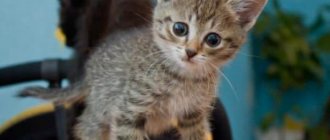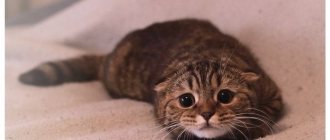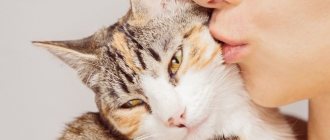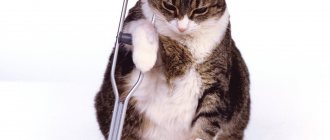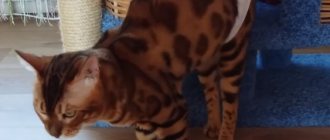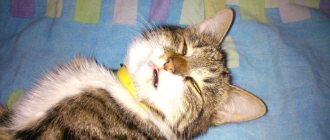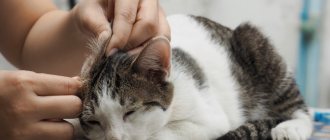Tachycardia in cats. What to do if your heart is at its limit
The heart is a perpetual motion machine that pumps thousands of liters of blood through the body of an animal or a person every day. The life and health of our pets depends on its condition. Even relatively safe tachycardia in cats sometimes leads to serious consequences, being a symptom of much more serious disorders. Today we will talk about the causes and consequences of this phenomenon, as well as measures that help improve the functioning of the vascular system and the heart itself.
What it is?
Tachycardia is a condition in which the heart of an animal contracts at a higher frequency (sometimes at the limit of its capabilities) than is intended by nature. This pathology leads to the development of more serious heart diseases and leads to wear and tear of this organ. The cause may be some kind of heart muscle disease that the cat already has, as well as some types of hormonal disorders or metabolic problems. Tachycardia is fraught with the development of atrial fibrillation. It is almost impossible to remove an animal from this state. The disease can also result in asystole, in which the heart stops contracting altogether.
Main reasons
- Congenital defects (especially obstructive cardiomyopathy - narrowing of the aortic lumen).
- Congenital diseases of the heart valves.
- Excessive and incorrect treatment, incompatibility of drugs used.
- Hyperthyroidism (excessive production of thyroid hormones).
- Tachycardia is often provoked by pancreatitis.
Ventricular and interventricular tachycardia are especially common: in cats, these pathologies can very often be found in old animals. Hereditary arrhythmias play a significant role. In addition, the disease may be a consequence of myocardial pathologies associated with cardiomyopathy (disease of the heart muscles), valve defects or myocarditis (inflammation of the heart muscle). To date, there is no sufficiently reliable treatment to prevent sudden death in animals with symptoms of ventricular tachycardia.
Clinical manifestations
- Constant weakness, in some cases the cat may even faint at the slightest exertion.
- Resistance to other diseases decreases.
- In some cases, there may be no symptoms at all. Most often, this is typical for fairly young animals, whose body can compensate for the pathology (up to a certain time).
Diagnosis information
The veterinarian will need to obtain all the necessary information from the animal’s owner, including information about the animal’s chronic diseases, which may have caused the development of tachycardia. Blood, urine and electrolyte tests are needed. The latter is very important: you need to find out whether the animal has developed hypokalemia or hypomagnesemia. These pathologies always lead to disturbances in the functioning of the heart. Blood biochemistry will help find signs of pancreatitis or hyperthyroidism. An echocardiogram is used to perform an accurate analysis, as well as to determine the extent of the process.
But the most important and guaranteed reliable method is taking an electrocardiogram (ECG). The graph will allow you to visualize the distribution of electric current in the heart muscle, which will allow you to identify almost any cardiac pathology. An echocardiogram is also important, used to check for structural heart disease. Currently, the most advanced clinics offer services for attaching special autonomous cardiac monitors. Such a device records heart rate and breathing rate every second, while simultaneously taking an ECG. This allows you to determine the cause of the disease as accurately as possible, but such diagnostics are not cheap.
Therapy
In many cases of mild tachycardia, treatment consists of prescribing medications that help restore normal electrolyte balance. If the cat is unstable (severe weakness, fainting, or arrhythmic episodes), hospitalization and treatment in a clinical setting with continuous intravenous drug infusion may be required. Once the animal's condition has stabilized, oral medications may be prescribed. It should be remembered that all medications prescribed by the veterinarian must be given to the animal in strict accordance with his instructions. This is due to the possibility of relapses of the disease. Finally, older and weaker cats often require lifelong treatment, as the worn-out heart requires constant support.
The cat's pulse is higher than normal
We found out above what a cat's pulse should be normally. But what if the pulse rate of an adult animal exceeds the specified limits, exceeding 150 beats per minute? Then we can safely talk about tachycardia
– pathological increase in heart rate. This is a dangerous disease that, if untreated, can lead to serious problems: ischemia, heart failure, thromboembolism, myocardial hypoxia, pulmonary edema and general deterioration of the body. If you do not seek medical help on time, unfortunately, death cannot be ruled out.
In addition to a rapid pulse, tachycardia in a cat can be recognized by the following symptoms:
Severe, persistent weakness (the cat looks tired even if it moves very little);
Arrhythmia (pulse is irregular, the heart beats either too quickly or too slowly);
Frequent breathing, shortness of breath even after a quiet walk;
Paleness of the mucous membranes;
The most common causes leading to the development of tachycardia in cats include:
- Heart disease (cardiomyopathy, myocarditis, etc.);
Diseases of the respiratory system, non-infectious and infectious (pulmonary failure, lung cancer, tuberculosis, pneumonia, etc.);
Endocrine disorders (diabetes mellitus, hyperthyroidism);
Inflammatory processes (pancreatitis, gastritis, colitis, endometritis, etc.);
If your cat's pulse is constantly elevated, you should visit your veterinarian (ideally, a veterinary cardiologist) as soon as possible. The specialist will take the animal’s blood and urine for analysis, conduct an electrocardiogram and echocardiogram, and, if necessary, an ultrasound and x-ray of the sternum and abdominal cavity. Treatment will be prescribed after an accurate diagnosis has been made. But we strongly recommend that you refrain from self-medication so that something irreparable does not happen.
Pericarditis in cats
Pericarditis in cats
accompanied by inflammation of the heart sac. According to the course, pericarditis can be acute and chronic, by origin - primary and secondary, by the distribution of the pathological process - focal and diffuse, by the nature of the exudate - serous, fibrinous, hemorrhagic and purulent.
Etiology.
Inflammation of the cardiac sac often occurs against the background of colds, infectious or invasive diseases, as well as during poisoning and penetrating wounds. Pericarditis can develop as a result of the transition of the inflammatory process from the myocardium, pleura, and lungs.
Pathogenesis.
With dry pericarditis, the inflammatory process involves the parietal and visceral surfaces with effusion and the deposition of fibrin on them. The cardiac sac becomes thickened, less elastic and smooth; the presence of roughness increases friction, intensifies inflammatory processes, causes the formation of adhesions, and complicates the functioning of the heart. The accumulation of exudate in the heart sac (exudative pericarditis) helps to reduce the contractile force of the myocardium, as it constantly compresses the organ, complicates its blood circulation, and most importantly, inflammatory products are absorbed into the blood, causing intoxication of the body. The resulting exudate negatively affects the heart muscle. At the same time, the pressure in the veins increases, congestive edema develops in organs and tissues, and with a decrease in blood pressure, the overall blood flow slows down.
Symptoms.
The general condition of the cat depends on the severity and duration of the primary disease. If blood circulation is impaired, swelling of the muscles and subcutaneous tissue is recorded: the tissues are juicy and flabby.
The listed changes are diagnosed in the chest, abdomen, perineum; increased heart rate, pain on palpation in the left chest area, increased general temperature; the heartbeat is increased. Rubbing or splashing noises can be detected by auscultation. The wall of the jugular vein is tense. Sick cats lie with their necks stretched forward and their nasal openings are dilated. Subsequently, against the background of heart failure, shortness of breath, cyanosis, and swelling of the distal part of the extremities (paws), ears, eyelids, and intermaxillary space develop. The animal is depressed, groans at times, hunches over when moving, and has a decreased or absent appetite. At autopsy, the presence and nature of the exudate, the condition of the walls of the pericarditis, changes in the parenchymal organs and other signs are clarified.
Diagnosis.
Fibrinous (dry) pericarditis is determined by friction noises and tenderness of the left side wall, increased cardiac impulse, tachycardia, edema, and fluoroscopy. Exudative pericarditis takes longer and is more severe. The diagnosis is made on the basis of a scattered cardiac impulse, the presence of muffled tones, splashing noises, excessive filling of the jugular veins, the clinical picture of the blood and the condition of the sick cat. The forecast is cautious.
Treatment of pericarditis in cats.
Aimed primarily at eliminating the underlying disease that caused pericarditis. At the beginning of the development of the pathological process, cold is prescribed on the left side, oxygen inhalation, nutrition is improved, puncture is performed and exudate is removed from the cardiac sac. Antiseptic solutions can be injected into the pericardial cavity and then removed. It is advisable to use cardiac, diuretics (bearberry leaves, parsley fruits, juniper berries), antibiotics (benzylpenicillin, ecmonovocillin, bicillin, streptomycin, tetracycline hydrochloride, chloramphenicol, oletethrin), sulfonamides (streptocide, norsulfazole, sulfadimezin, etazol), potassium acetate.
Types of pathology
The heart is a unique type of muscle tissue that can contract throughout the life of the body. Due to these contractions, blood supply occurs to all organs and tissues of the animal. The health of the heart muscle, myocardium, determines not only the cat’s life itself, but also its quality. Disturbances in the functioning of the heart in animals are both congenital and acquired.
Congenital
Congenital myocardial defects are diagnosed by veterinarians in approximately 1% of newborn babies. In this case, pathological underdevelopment of the heart valves, especially the mitral valve, impaired development of the arterial ducts, as well as pathologies of the conduction of nerve impulses through the organ are most often observed.
Anatomy of a healthy cat heart
Breeds such as the Maine Coon, Abyssinian cat, as well as popular British and Scottish breeds have a genetic predisposition to congenital heart pathologies.
Veterinarians diagnose the following congenital defects of the heart muscle.
The prognosis is unfavorable.
As a result, the vascular network and the left side of the myocardium are overloaded. If the right side of the heart is not involved in the process, then the prognosis is positive.
Unlike other congenital pathologies, subaortic stenosis does not lead to early death of the body, but significantly worsens the pet’s quality of life.
Pathology is rarely diagnosed in cats.
Animals with congenital anomalies of the organ, as a rule, die in the first year of life due to the fact that the structure of the cat’s heart is changed. This is due to severe overload of the myocardium, the development of heart failure and concomitant vascular diseases. Defects such as aortic stenosis and tetralogy of Fallot are serious diseases with a poor prognosis.
If congenital anomalies are detected in the offspring, the parents are excluded from the breeding program.
Appeared with age
Myocardial diseases often develop gradually and appear in adulthood or closer to old age. Experts attribute this to the fact that cats are not very active animals and do not experience serious physical exertion. With age, couch potatoes may develop the following pathological conditions of the heart muscle:
- Pathologies of inflammatory non-infectious nature. Often, such diseases are a consequence of the use of medications (antimicrobial agents, painkillers and anti-inflammatory drugs). Cats most often suffer from myocardosis. At the same time, dystrophic processes develop in the heart muscle. There are many causes of the disease: unbalanced feeding, concomitant non-communicable diseases, helminthic infestations.
- Cardiac pathologies of an infectious nature. Transferred viral and bacterial infections lead to the fact that pathogenic microorganisms enter the heart muscle through the bloodstream due to the weakened immunity of the animal. The most common diagnoses in cats are myocarditis and endocarditis. The disease is observed in both acute and chronic forms.
The cause of the pathology is septic processes, pancreatitis, panleukopenia, purulent processes in the uterus, as well as acute intoxication.
- Hypertrophic cardiomyopathy . This disease is accompanied by pathological thickening of the myocardium, which leads to the development of severe heart failure. The pathology is widespread among representatives of the cat family, especially among Maine Coons, Scottish Folds, Norwegian Forest cats and representatives of the British breed.
Read also: Tachycardia symptoms and treatment medications
The disease develops gradually. Thickening of the myocardium leads to stagnation and enlargement of the left side of the organ. At later stages of development of the pathology, pulmonary edema, the appearance of fluid in the pleural area, and death may occur. A timely diagnosis can extend the life of a sick animal for many years.
Secondary cardiomyopathy develops against the background of diseases of other organs, most often due to hyperthyroidism. High levels of thyroid hormones lead to constant tachycardia, as a result of which the heart wall thickens and the organ works under overload.
A complication of the disease in the form of thromboembolism poses a threat to the pet. Blockage of large vessels usually leads to death.
As for cardiac arrhythmias, veterinary specialists do not classify these disorders (except congenital) as a separate group of diseases. Most often, arrhythmia occurs due to a malfunction of the endocrine system and itself leads to the development of cardiac pathology.
For information about hypertrophic cardiomyopathy in cats, watch this video:
Thrombocytopenia in cats
Thrombocytopenia occurs when platelets are destroyed or insufficiently produced, which is characterized by their low level in the animal’s blood. Since platelets are responsible for the formation of blood clots, with thrombocytopenia, blood clotting disorders are observed, the time of blood clot retraction and, consequently, the duration of bleeding increases. As a rule, the disease is accompanied by hemorrhages in the skin and mucous tissues of the animal’s gastrointestinal tract.
Thrombocytopenia occurs when platelets are destroyed or insufficiently produced, which is characterized by their low level in the animal’s blood. Since platelets are responsible for the formation of blood clots, with thrombocytopenia, blood clotting disorders are observed, the time of blood clot retraction and, consequently, the duration of bleeding increases. As a rule, the disease is accompanied by hemorrhages in the skin and mucous tissues of the animal’s gastrointestinal tract.
Thrombocytopenia in cats can be either autoimmune or acquired.
Autoimmune thrombocytopenia in cats
The causes of congenital thrombocytopenia can be various diseases of the animal during pregnancy (hepatitis, toxins and infections, etc.), as well as congenital leukemia and granulomatosis. Often, thrombocytopenia triggers a failure of the autoimmune mechanism, in which lymphocytes produce antibodies to unchanged platelets. In this case, immunoglobulin G attaches to platelets and destroys them. This thrombocytopenia is one of the causes of deficiency of vascular-platelet hemostasis in cats. Autoimmune thrombocytopenia occurs most often in adult cats and may be accompanied by anemia.
Acquired thrombocytopenia in cats
Acquired thrombocytopenia is quite common in cats. Its cause may be disturbances in the structure of platelets due to drug poisoning or viral damage. How can medications cause thrombocytopenia in cats? Estrogens and a number of antibiotic drugs slow down the production of platelets in the bone marrow, and aspirin, penicillin and a number of other drugs interfere with the function of platelets in the animal's blood. Therefore, the use of these drugs is strictly controlled by the attending veterinarian and with the help of regular blood tests to check for a decrease in platelet levels. At the end of the course of treatment, the platelet level returns to normal, however, if the drugs affect the bone marrow, full restoration of its functions may take a longer period.
Symptoms of thrombocytopenia in cats
The most obvious symptoms of thrombocytopenia are capillary bleeding from the gums and nose, redness of the skin, and increased duration of bleeding. Petichiae may be observed on the skin and mucous membranes - this is a small bloody rash. The petichiae coalesce into large bruise-like bruises. In rare cases, bleeding occurs from the gastrointestinal tract, genitourinary system, and lungs. In general, the animal is lethargic, gets tired easily, and tachycardia is observed.
Tests can reveal: a decrease in the number of platelets, a decrease in hemoglobin and red blood cells, a decrease in blood clotting time and blood clot retraction time.
Treatment of thrombocytopenia in cats
As first aid to an animal with prolonged bleeding, it is necessary to use hemostatic agents and, possibly, a blood transfusion. To treat thrombocytopenia, corticosteroids and other drugs that promote the formation of new platelets in the blood are used. In severe cases, they sometimes resort to excision of the spleen, as it produces antibodies that destroy platelets.
Thrombocytopenia is a very dangerous disease and is prone to relapses. Therefore, it requires regular supervision by a specialist. A relapse can be triggered by animal vaccination, infection, pregnancy and a number of other factors.
Specialists from the VEGA network of veterinary clinics provide round-the-clock care to animals, diagnose and successfully cope with complex diseases such as thrombocytopenia. Entrust the health of your cat to professionals who have extensive experience and the latest equipment at their disposal. Your pet will undergo treatment and return to a healthy and fulfilling life, full of the joy of communicating with its owner.
Causes of heart disease in cats
The heart of animals is practically no different from the human heart and performs the same functions in the body, taking part in blood circulation processes. The only difference is the ratio of the organ relative to body weight and heart rate. The heart distills oxygen and useful substances, saturating organs, tissues, and cellular structures with it.
Important! A cat's heart beats between 100 and 140 beats per minute. In kittens this figure is slightly higher. After activity, stress, or overheating, the heart rate increases.
Failures in the functioning of the cardiovascular system, cardiac pathologies of various etiopathogenesis worsen the quality, reduce the life expectancy of animals, lead to disruption of gas exchange, the functioning of internal organs and body systems.
Causes of heart disease in cats:
Often, pathologies, heart disease in cats, and disturbances in the functioning of the cardiovascular system in animals occur against the background of diseases and infections of various etiologies and natures. For example, one of the causes of cardiopathy can be called disturbances in the functioning of the thyroid gland. Due to the increased production of thyroid-stimulating hormone, the walls of the ventricles of the heart thicken, the volume of ejected blood decreases, which leads to the fact that the heart literally works for wear and tear.
Often, heart disease develops against the background of diabetes, obesity, and parasitic infections. Long-term use of certain medications can also lead to disruption of the heart of animals.
Regarding breed predisposition, according to statistics, Bengals, Persian, Siamese, Thai, Abyssinian, Burmese cats and their mixed breeds suffer from heart ailments of various types.
In these breeds, kittens are often born with congenital heart defects. In this case, pathologies can develop at an older age.
In some cases, the causes of heart disease are unknown, and in order to determine what caused the malfunction of the cardiovascular system, a number of diagnostic studies and measures are required.
Tachycardia in cats. What to do if your heart is at its limit
The heart is a “perpetual motion machine” that pumps thousands of liters of blood through the animal or human body every day. The life and health of our pets depends on its condition. Even relatively safe tachycardia in cats sometimes leads to serious consequences, being a symptom of much more serious disorders. Today we will talk about the causes and consequences of this phenomenon, as well as measures that help improve the functioning of the vascular system and the heart itself.
What it is?
Tachycardia is a condition in which the heart of an animal contracts at a higher frequency (sometimes at the limit of its capabilities) than is intended by nature. This pathology leads to the development of more serious heart diseases and leads to wear and tear of this organ. The cause may be some kind of heart muscle disease that the cat already has, as well as some types of hormonal disorders, or metabolic “problems.” Tachycardia is fraught with the development of atrial fibrillation. It is almost impossible to remove an animal from this state. The disease can also result in asystole, in which the heart stops contracting altogether.
Main reasons
- Cardiomyopathy.
- Congenital defects (especially obstructive cardiomyopathy - narrowing of the aortic lumen).
- Congenital diseases of the heart valves.
- Excessive and incorrect treatment, incompatibility of drugs used.
- Hyperthyroidism (excessive production of thyroid hormones).
- Oncological pathologies.
- Myocarditis is inflammation of the heart muscle.
- Tachycardia is often provoked by pancreatitis.
Ventricular and interventricular tachycardia are especially common: in cats, these pathologies can very often be found in old animals. Hereditary arrhythmias play a significant role. In addition, the disease may be a consequence of myocardial pathologies associated with cardiomyopathy (disease of the heart muscles), valve defects or myocarditis (inflammation of the heart muscle). To date, there is no sufficiently reliable treatment to prevent sudden death in animals with symptoms of ventricular tachycardia.
Clinical manifestations
- Constant weakness, in some cases the cat may even faint at the slightest exertion.
- Resistance to other diseases decreases.
- Sudden death.
- In some cases, there may be no symptoms at all. Most often, this is typical for fairly young animals, whose body can compensate for the pathology (up to a certain time).
- Increased heart rate, rapid breathing.
- Symptoms of congestive heart failure.
Diagnosis information
The veterinarian will need to obtain all the necessary information from the animal’s owner, including information about the animal’s chronic diseases, which may have caused the development of tachycardia. Blood, urine and electrolyte tests are needed. The latter is very important: you need to find out whether the animal has developed hypokalemia or hypomagnesemia. These pathologies always lead to disturbances in the functioning of the heart. Blood biochemistry will help find signs of pancreatitis or hyperthyroidism. An echocardiogram is used to perform an accurate analysis, as well as to determine the extent of the process.
But the most important and guaranteed reliable method is taking an electrocardiogram (ECG). The graph will allow you to visualize the distribution of electric current in the heart muscle, which will allow you to identify almost any cardiac pathology. An echocardiogram is also important, used to check for structural heart disease. Currently, the most “advanced” clinics offer services for attaching special autonomous cardiac monitors. Such a device records heart rate and breathing rate every second, while simultaneously taking an ECG. This allows you to determine the cause of the disease as accurately as possible, but such diagnostics are not cheap.
Description
To pump blood to the lungs and body, the heart must work in harmony. The heart has an electrical conduction system that is responsible for controlling heart rate. This electrical conduction system generates electrical impulses (waves) that travel throughout the musculature of the heart, stimulating the heart muscles to contract and push blood through the internal arteries into the body. There are two nodes in the heart that play an important role in this conduction system.
The sinus node is a cluster of similar cells located in the right atrium.
Its purpose is to generate electrical impulses and serve as a pacemaker. The other node is called the atrioventricular node. Like the sinus node, it is a clustered collection of similar cells located in the right atrium. The atrioventicular node receives impulses from the sinus node and, after a short delay, sends impulses to the ventricles. This delay allows the atrium to pump blood into the ventricle before the ventricular muscles contract.
The atrioventricular node can also take the place of the sinus node as a pacemaker if the sinus node is adversely affected by a pathological condition of the heart.
READ Breeding and keeping pheasants at home
Ventricular premature complexes on an electrocardiogram (ECG, a recording of the electrical activity of the heart) are characterized by abnormal (too wide and/or oddly shaped) QRS complexes. A condition occurs that indicates a change in the electrical potential in one heartbeat.
Therapy
In many cases of mild tachycardia, treatment consists of prescribing medications that help restore normal electrolyte balance. If the cat is unstable (severe weakness, fainting, or arrhythmic episodes), hospitalization and treatment in a clinical setting with continuous intravenous drug infusion may be required. Once the animal's condition has stabilized, oral medications may be prescribed. It should be remembered that all medications prescribed by the veterinarian must be given to the animal in strict accordance with his instructions. This is due to the possibility of relapses of the disease. Finally, older and weaker cats often require lifelong treatment, as the worn-out heart requires constant support.
Attack of tachycardia in a cat
Hello! Today our cat (mongrel, not sterilized, 10 years old) had something like a seizure, but first I’ll probably describe our medical history, it’s quite long, but so as not to miss anything I’ll describe the whole situation. In general, our diagnosis was breast cancer, based on the results of histology after surgery to remove one affected ridge of breast tissue in February of this year. Tests were done before the operation, everything was fine, the ultrasound of the heart showed nothing wrong, except for minor age-related changes. She recovered normally after the operation without any complications, all tests were normal, X-rays of the lungs and ultrasound results showed no metastases. However, a relapse occurred, the tumor began to form and grow in the lymph node on the side from which the first ridge was removed. Then, in March, we carried out the first stage of chemotherapy with Doxorubicin, she tolerated it normally, only sporadic vomiting, good blood tests before and after. After 2 weeks, on March 31, the second stage of the operation was performed, the second ridge and the affected lymph node were removed. The operation was successful, the only thing they say was that there was a pressure surge. They left him in the hospital for a day, but the cat was under severe stress, the temperature remained at 40, and they decided to take her home. The first days after the operation I felt fine, but gradually I began to eat less and had no bowel movements for about a week. 5 days after the operation, on April 5, we completed the second course of chemotherapy (we have it once every 3 weeks). The cat was already very lethargic by the time of chemotherapy, did not eat, had no stool for a week, and was thirsty. They did an enema, there was only a single stool, they prescribed an IV, they also did biochemistry for kidney parameters, which turned out to be 3 times too high (urea 27, creatinine 600, potassium 5). They prescribed drips, also gave Duphalac and Acilok for constipation, tried to force-feed him purina NF, but not very successfully. On the third day of drips, i.e. Yesterday we decided to leave the cat for a day hospital, for IV drips at a constant rate. Yesterday they again took a blood test for general and biochemistry tests, plus a urine test. According to the analysis, everything was fine, kidney parameters dropped to normal, potassium was slightly elevated. Urine analysis is normal in density. In general, it showed a low level of leukocytes, they gave an injection of Epocrine 1000. They measured blood pressure and temperature, everything was normal, but the cat was under severe stress in the hospital and behaved aggressively, although she was always very calm at appointments with me. They took her home, she even ate a little on her own. Everything was fine, she fell asleep, she trembled a little in her sleep, but it seemed normal to me, although the last few days her breathing seemed a little faster and heavier, but when we listened to her, everything was normal. At about 3 o'clock in the morning today she suddenly woke up, jumped up, her paws began to move apart, she could not stand, she was like a rag doll. Then she opened her mouth, drooling began to flow, she stood there for a couple of minutes, but I didn’t notice any rapid breathing. Nevertheless, they were urgently taken to the clinic, i.e. 10 minutes passed from the beginning of the attack, on the way the condition improved a little, she stood firmly on her paws, closed her mouth, but was a little lethargic. Upon arrival to the doctor (in total, 20 minutes passed from the beginning of the attack), upon examination they found only tachycardia, slightly rapid breathing, they did not take tests, because took them 12 hours ago. Temperature 38.2. The doctor determined the pressure “on the eye” to be normal. We gave an injection of Relanium and prescribed Vazotop 0.5 mg once a day for life and Kot Bayun or Novopassit, but we already added Kot Bayun to her water, because... trips to the clinic frighten her very much, she has become more nervous and irritable. Upon arrival home, she ate well, but as I understand it, this is the effect of Relanium, now she is sleeping, but often wakes up. The heart rate is currently normal at 120 beats per minute. But my breathing is rapid, 40-45 breaths per minute. There is also a slight trembling in the body (and this is after Relanium). There is still no bowel movement for 4 days, although I give Duphalac. Of course, she ate almost nothing these days, but there was no stool or even the urge to stool at all.
Please tell me, are you familiar with cases of such attacks (because the doctor receiving us was in difficulty), what tests should still be done, is it necessary to do an ECG (we were not prescribed, they only told us to monitor the condition)? Is it possible for such an attack to happen again? Should I start giving Vazotop and continue for the rest of my life? Is it possible that this is a reaction to stress or could there be more serious reasons? I wouldn’t write, but our attending physician will only be there the day after tomorrow, maybe you can advise whether it’s worth carrying out any urgent procedures right now? Thank you very much in advance!
Methods for measuring heart rate in cats
Sometimes, in order not to miss any disease in your pet, it is enough to simply measure its pulse in time. Let's look at how this is done. We humans, when we want to count our heart rate, we squeeze the wrist area. Where is a cat's pulse? The easiest way for an animal to feel the pulsation of the large femoral artery is to press on the inside of the thigh (in the groin, where the cat's leg connects to the body). But here we note that some wayward pets may simply not allow the owner to touch the groin area. Otherwise, the pulse of a cat, cat or kitten can be measured by pressing the palm of the hand on the sternum area on the left side
(where you can feel the heartbeat).
The cat's pulse rate is usually measured over 1 minute. But what if the cat is indignant (breaks out, tries to bite, hisses, etc.)? Measurement time can be halved or quadrupled. For an aggressive pet, the measurement time can be reduced to 15 seconds, and then simply multiply the resulting value by 4 (the result of a 30-second measurement must be increased by 2).
When figuring out what your cat's heart rate is, it's important to keep these things in mind:
- Pulse counting should be done when the animal is as calm as possible
. An excited cat's pulse is always significantly higher than normal;
During the measurement, the owner should under no circumstances shout at the cat.
, hitting or squeezing it forcefully. This will cause the pulse of the unnerved animal to jump up;
Do not take the pulse of a sleeping pet
. During sleep, cats' heart rate is lower than when awake;
- There is no need to put too much pressure on the cat's groin or chest
. With strong pressure, it is difficult to calculate the pulse rate correctly.
Symptoms and treatment of heart failure in cats
Heart failure is the inability of the heart to pump the amount of blood the body needs. This disease occurs as a result of past infectious diseases. Heart failure is the most common cause of sudden death in pets. It affects not only dogs, but also cats.
Types of heart failure:
- Chronic heart failure. It develops slowly, sometimes imperceptibly, but at the same time, steadily.
- Acute heart failure develops quite rapidly, its time varying from several minutes to several hours.
As a result of the acute form, the cat instantly develops pulmonary edema, symptoms of which may include blood discharge from the mouth and nose, as well as shortness of breath.
Congenital and acquired heart diseases in cats
Pets are susceptible to various ailments from birth and throughout their lives. Among internal non-contagious pathologies, heart disease in cats occupies one of the leading places. According to veterinary statistics, every tenth pet suffers from heart disease to one degree or another. A feature of myocardial abnormalities is the hidden nature of the disease, difficulty in diagnosis and long-term treatment.
Read in this article
Symptoms
Symptoms of heart disease in cats are not always visible, but she cannot complain about her health. Therefore, the health of the pet is entirely in the hands of the owner. He must monitor his pet and, upon discovering the first symptoms of the disease, should seek advice from a veterinarian.
A cat's panting with a protruding tongue is a sign of heart disease.
- Fatigue is difficult to notice in a cat, since it leads a generally quiet lifestyle.
- Dyspnea. Breathing occurs through the abdomen, without the participation of the chest.
- An attack accompanied by loss of consciousness. The cat, at this time, can be mistaken for a dead animal. Usually the attack passes quickly, but it happens that pets die, as their body experiences an acute lack of oxygen.
- The animal wheezes and meows terribly.
- Heavy breathing indicates pulmonary edema.
- Complete or partial paralysis of the hind legs.
- Cardiopalmus.
- Cyanosis of the gums.
- Loss of appetite.
In cats, coughing is not a cardiac symptom.
First aid for a cat who faints
The onset of an attack requires quick and correct actions by the owner, since, sometimes, it can end in death.
- Lay the cat down, and it is necessary to give her a side position of her head.
- Pull out your tongue.
- Place a cool compress on your head.
- Place cotton wool soaked in ammonia to your nose.
- The paws must be fixed higher than the head, so there will be more blood flow to the head.
- Call your veterinarian.
How to distinguish a healthy cat from a sick one
Since cats generally lead a calm lifestyle, they are couch potatoes, not all owners can distinguish a healthy animal from a sick one. She can report any changes in well-being by changing her behavior, that is, if the cat used to behave independently of the owner, but now does not leave him, then this indicates that something is bothering her.
Some people think that purring in cats is a sign of health. This is wrong. Purring, abruptly replaced by aggression or growling, indicates that she is in pain.
A healthy animal has:
- Smooth wool.
- The nose is wet and cold.
- The mucous membranes of the eyes are pinkish in color.
- The animal is vigorous and active.
- Lethargic, lies more than usual.
- He tries to get away from everyone to a secluded place.
- Can be very excited.
- The meow is pitiful.
- Movements are clumsy.
- The nose is warm with cracks.
Auscultation of the lungs in cats before surgery
Auscultation when assessing pulmonary function
took into account the fact that vesicular breathing in cats is noisier than in dogs. The presence of vesicular respiration in all parts of the lungs was assessed. In clinically healthy cats, wheezing and crepitus should be absent.
Signs of respiratory failure in cats - tachypnea (accelerated breathing rate), hyperpnea (increased breathing amplitude), orthopnea (forced sitting posture), cyanosis (blue color of the mucous membranes) should alert a veterinarian. Having some manual experience, percussion examination of the chest can reveal dullness with hydrothorax (chylothorax, hemothorax, pyothorax), diaphragmatic hernia, massive tumor in the chest cavity, or a box sound with pneumothorax. These diseases are also characterized by a sharp decrease in vesicular respiration and signs of acute respiratory failure (dyspnea, tachypnea, hyperpnea, cyanosis). It is sometimes difficult to detect cyanosis in anemic cats; in such cases, the mucous membranes are gray in color. For any abnormalities in the respiratory tract in cats, we recommend additional radiographic and ultrasonographic examination of the chest.
^Top
Causes of heart failure
- Congenital heart pathologies. In cats they are quite rare, occurring in approximately 2% of all cases.
- Diseases of the heart muscle caused by infectious diseases.
- Cardiomyopathy, which is caused by an inadequate diet in cats. They, as a rule, do not receive enough taurine, which is part of raw fish and meat. During cooking, it is destroyed.
- Heartworms and their larvae are found in mosquitoes. They are microscopic in size. When a mosquito bites, their larvae enter the animal’s bloodstream and settle in the pulmonary artery. Heartworms can grow up to 30 centimeters in size. With their presence in the circulatory system, they interfere with the outflow of blood and cause enormous damage to the arteries. Adults entangle the heart, thereby interfering with its full functioning. Heartworms can be detected using a blood test.
- Age-related hormonal changes. Heart failure is thought to occur in cats over 6 years of age.
- Metabolic disease. Sometimes it is caused by improperly structured nutrition.
Cats should be periodically screened for heartworms to help prevent heart disease. If a taurine deficiency is noticed in a timely manner, it must be introduced into the cat’s food, due to which the vital activity of the heart muscle is restored.
Diagnostics
Diagnosis must be carried out by a qualified veterinary cardiologist in order to prescribe the correct treatment. Typically it includes:
- Blood analysis.
- Analysis of urine.
- Ultrasound.
- Chest X-ray.
- ECG.
If a cat has been diagnosed with heart failure, then it should be excluded from planning for breeding, since the hereditary factor plays an important role.
Diagnostics
Your veterinarian will conduct a thorough physical examination of your cat, taking into account the history of symptoms and possible incidents that may have led to this condition. A complete blood count will be performed, including a blood chemistry panel, complete blood count, urinalysis, and electrolyte panel. An electrolyte panel will show if there is hypokalemia and hypomagnesemia. A blood test will also show signs of pancreatitis and hyperthyroidism, if any.
A cardiac echocardiogram should be performed to check for structural heart disease. Long-term ambulatory (Holter) ECG recordings may be done to detect transient ventricular arrhythmias in patients with unexplained syncope or weakness.
Only a doctor can determine that a pet’s symptoms of illness relate specifically to heart disease. And often a clinical examination and listening to heart murmurs are not enough to make a diagnosis and additional examinations are needed. What may be required for diagnosis:
- History (collection of information from the owner)
- Physical examination (examination, palpation, listening with a phonendoscope (auscultation))
- Tonometry (pressure measurement)
- Electrocardiography (ECG - measurement of the electrical activity of the heart) is not an informative method for diagnosing heart disease, but is used to identify pathologies associated with circulatory rhythm disturbances
- X-ray (the main diagnostic method) - provides information about the shape and size of the heart, the condition of the lungs (the presence of edema, blood stagnation, etc.). Photos must be of high quality.
- Echocardiography (ultrasound is the main diagnostic method) - provides information about the thickness of the walls, the size and shape of the atria, the diameter of the aorta, the rhythm of contractions, the presence of blood clots, etc. Modern ultrasound machines can use the Doppler effect to assess blood flow.
READ How many kittens can a cat give birth to?
Thank you for watching!
If you liked the video, share it with your friends:
Treatment and care
Treatment of cats for this disease depends on the severity of the disease. Sometimes it is carried out exclusively during a daily stay in a veterinary clinic. Cats do not undergo heart surgery. During illness, they are prescribed only drug treatment. The earlier they are diagnosed with heart failure, the better their chances of survival. For recovery you need:
- Complete rest of the animal. The pet must be limited from any stress - this could be a working vacuum cleaner, traveling on public transport or the arrival of guests.
- Treatment with diuretics removes excess fluid from the body. During illness, fluid can accumulate near the lungs, thereby causing swelling. In the chest, causing pleurisy. In the abdominal cavity, causing ascites. Reducing the amount of fluid in the body helps reduce the load on the heart.
- Treatment with ACE inhibitors, which reduce the load on the heart by increasing blood flow.
- Positive inotropes make the heart pump more blood, control the heartbeat, and slow it down so it pumps more blood into the body.
- When the fluid content in a cat’s body is greatly increased, the veterinarian will pump it out and thereby remove it from the body. The cat will feel relief for a while, but this will not last long, as the fluid will return. Pumping is carried out by inserting a sterile needle into the required place.
- Balanced diet.
Heart failure in an animal requires careful care:
- Cats need low-salt food. Salt retains water in the body, which leads to poor circulation.
- Feed with a high content of taurine and protein.
- Heart failure requires regular veterinary consultations and ongoing treatment.
Symptoms and signs that should alert you
It is quite difficult to suspect heart problems in a domestic cat. This is due both to the lack of activity and physical activity, and to the blurred clinical picture of the onset of the pathology. However, owners should be aware of the symptoms of heart disease in cats:
- Decreased motor activity, lethargy, apathy, drowsiness . The cat, feeling weak, moves less.
- Rapid breathing . Normally, a cat makes 20 - 30 breathing movements per minute. If the number of inhalations and exhalations is more than 40, you should show the animal to a veterinarian.
- Heavy breathing, shortness of breath . The animal experiences difficulty breathing both during rest and during increased physical activity. The owner often observes the pet breathing with its mouth open and its tongue hanging out. In this case, breathing movements are carried out not by the chest, but by the stomach. Often, a cat takes a pose of oxygen starvation: crouching on the ground with its belly, the pet stretches its head and neck forward. Elbows placed at the sides improve oxygen supply to the chest.
- Decreased appetite . During meals, the animal holds its breath, which, against the background of oxygen starvation due to heart pathology, leads to poor appetite in the pet.
- Pale or blueness (cyanosis) of the mucous membranes.
- The owner can observe how strongly the cat's heart beats as the disease progresses by placing his palm on the chest area. Tachycardia accompanies a number of cardiac pathologies, including myocarditis and endocarditis.
- In the later stages of the disease, the owner may observe a loss of consciousness in the pet . Fainting is caused by impaired blood supply to the brain.
- An unfavorable symptom is paralysis of the hind limbs . Thromboembolism (blockage of large blood vessels) is often a complication of hypertrophic cardiomyopathy.
